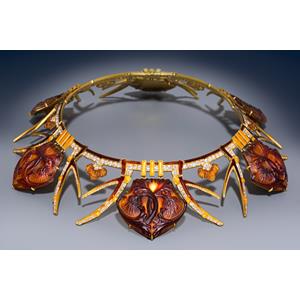IMAGE DETAILS

Epoque Fine Jewels
René Lalique (Ay 1860-1945 Paris)
Art Nouveau thistle necklace
Paris, circa 1905
Gold, diamond, enamel and glass
Signed: Lalique
The piece is housed in its original case, marked ‘Lalique, Place Vendôme 24, Paris’
Provenance: private collection, France
An impressive Art Nouveau gold, diamond, enamel and glass thistle flower necklace by René Lalique, consisting of six pentagonal plaques made from moulded amber-coloured glass, each adorned with two intertwined thistle flowers facing outward, topped by three yellow enamel rods. Flanking the plaques are long curved thorns, set with diamonds and accented with yellow and brown enamel. Between the thorns are small thistle flower motifs in moulded orange glass, enhanced with diamonds.
This exceptional Art Nouveau choker necklace by René Lalique (circa 1905, Paris) exemplifies his revolutionary use of glass in fine jewelry. The piece features six molded amber glass plaques decorated with intertwined thistle flowers, enhanced by diamonds and yellow and brown enamel on gold. The thistle flower motif, emblem of Lorraine and the Dukes of Lorraine, symbolizes courage and protection, reflecting the regional heritage of Nancy, where the original owner was a notable social figure likely to have commissioned it directly from Lalique.
Created during the period when Lalique moved his shop to 24 Place Vendôme, the necklace illustrates his transition from Art Nouveau to early Art Deco, blending naturalistic design with modern aesthetics. Its autumnal hues, sunlit enamel details, and radiant diamonds evoke both poetic beauty and symbolic depth. Lalique drew inspiration from wild flora rather than cultivated blooms, favoring authenticity and imperfection as expressions of nature’s truth.
This necklace, long preserved in a French private collection and once known only through drawings (including one published by Sigrid Barten), is a rare surviving example of Lalique’s innovation. It demonstrates his mastery in merging craftsmanship, symbolism, and modernity, affirming his reputation as the “inventor of modern jewelry.”



 download image
download image